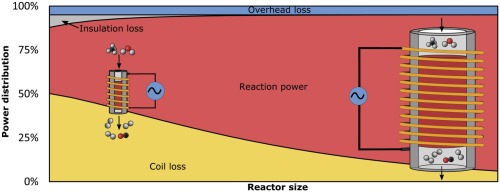Catalysis Today ( IF 5.3 ) Pub Date : 2019-05-08 , DOI: 10.1016/j.cattod.2019.05.005 Mads Radmer Almind , Søren Bastholm Vendelbo , Mikkel Fougt Hansen , Morten Gotthold Vinum , Cathrine Frandsen , Peter Mølgaard Mortensen , Jakob Soland Engbæk

|
Induction heating may be an electrical solution for heating of catalytic reactors. Recent studies have shown that CoNi nanoparticles may act as both inductors for hysteresis heating and catalyst, such that they in an alternating magnetic field are able to drive the strongly endothermic steam methane reforming reaction with > 90% gas conversion at temperatures of ≈800 °C. However, lab-scale induction-heated reactors are limited by low energy transfer efficiency and previous work did not optimize the surrounding instrumentation. Here, we focused on the optimization of an induction setup for steam methane reforming. The performance of the reactor system was investigated through experiments at varying alternating magnetic field conditions, to evaluate the effect of frequency and coil geometry. The results from these experiments were modelled by a simple theoretical framework. Increasing the frequency of the alternating magnetic field from 68 kHz to 189 kHz was found to increase the energy transfer efficiency. Moreover, the energy transfer efficiency also increased when going from a short and wide coil with height to radius ratio of 3.8 to a long and narrow coil with height to radius ratio of 10.8. Overall, the energy transfer efficiency was increased from an initial 11% in the bench scale reactor setup, to 23% in the optimized version. Moreover, combining the bench scale results with the theoretical framework we extrapolated the data to large-scale systems. The analysis indicated that the energy efficiency of induction-heated steam reforming systems scaled to larger H2 capacities may be above 80%. This efficiency would allow the technology to be competitive with other electricity driven routes to hydrogen production when considering only the energy requirements.
中文翻译:

改善感应加热蒸汽甲烷重整的性能
感应加热可以是用于加热催化反应器的电解决方案。最近的研究表明,CoNi纳米颗粒既可以充当磁滞加热的感应器,又可以充当催化剂,因此它们在交变磁场中能够在≈800°C的温度下以> 90%的气体转化率驱动强烈吸热的蒸汽甲烷重整反应。 。但是,实验室规模的感应加热反应堆受到能量传输效率低的限制,并且先前的工作并未优化周围的仪器。在这里,我们专注于蒸汽甲烷重整的诱导装置的优化。通过在变化的交变磁场条件下进行实验,研究了反应堆系统的性能,以评估频率和线圈几何形状的影响。这些实验的结果通过一个简单的理论框架进行建模。发现将交变磁场的频率从68 kHz增加到189 kHz可以提高能量传输效率。此外,当从高半径比为3.8的短而宽的线圈到高半径比为10.8的长而窄的线圈时,能量传递效率也得到了提高。总体而言,能量转移效率从台式反应器设置的最初11%提高到了优化版本的23%。此外,将基准规模的结果与理论框架相结合,我们将数据外推到大型系统。分析表明,感应加热蒸汽重整系统的能量效率可扩展到更大的H 发现将交变磁场的频率从68 kHz增加到189 kHz可以提高能量传输效率。此外,当从高半径比为3.8的短而宽的线圈到高半径比为10.8的长而窄的线圈时,能量传递效率也得到了提高。总体而言,能量转移效率从台式反应器设置的最初11%提高到了优化版本的23%。此外,将基准规模的结果与理论框架相结合,我们将数据外推到大型系统。分析表明,感应加热蒸汽重整系统的能量效率可扩展到更大的H 发现将交变磁场的频率从68 kHz增加到189 kHz可以提高能量传输效率。此外,当从高半径比为3.8的短而宽的线圈到高半径比为10.8的长而窄的线圈时,能量传递效率也得到了提高。总体而言,能量转移效率从台式反应器设置的最初11%提高到了优化版本的23%。此外,将基准规模的结果与理论框架相结合,我们将数据外推到大型系统。分析表明,感应加热蒸汽重整系统的能量效率可扩展到更大的H 当从高宽比为3.8的短而宽的线圈到高宽比为10.8的长而窄的线圈时,能量传递效率也会提高。总体而言,能量转移效率从台式反应器设置的最初11%提高到了优化版本的23%。此外,将基准规模的结果与理论框架相结合,我们将数据外推到大型系统。分析表明,感应加热蒸汽重整系统的能量效率可扩展到更大的H 当从高宽比为3.8的短而宽的线圈到高宽比为10.8的长而窄的线圈时,能量传递效率也会提高。总体而言,能量转移效率从台式反应器设置的最初11%提高到了优化版本的23%。此外,将基准规模的结果与理论框架相结合,我们将数据外推到大型系统。分析表明,感应加热蒸汽重整系统的能量效率可扩展到更大的H 将工作台规模的结果与理论框架相结合,我们将数据外推到大型系统。分析表明,感应加热蒸汽重整系统的能量效率可扩展到更大的H 将工作台规模的结果与理论框架相结合,我们将数据外推到大型系统。分析表明,感应加热蒸汽重整系统的能量效率可扩展到更大的氢2个容量可能超过80%。仅考虑能源需求时,这种效率将使该技术与其他电力生产氢气的方法具有竞争力。



























 京公网安备 11010802027423号
京公网安备 11010802027423号